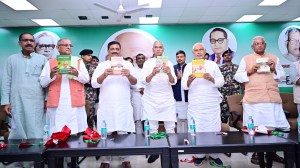Stay updated with the latest - Click here to follow us on Instagram
Green technology to power air-conditioners on trains
The Research Designs and Standards Organisation of Indian Railways has come up with a new technology to cater to the power requirements of the fully air-conditioned super fast trains,as well as other passenger trains,which will not only save fuel but also cut down on the cost of running the trains.
The Research Designs and Standards Organisation (RDSO) of Indian Railways has come up with a new technology to cater to the power requirements of the fully air-conditioned super fast trains,as well as other passenger trains,which will not only save fuel but also cut down on the cost of running the trains.
The green technology,called Head On Generation (HOG),is already being used in the New Delhi-Kalka Shatabdi Express for over a month now.
In 2007,the railway board approved of RDSOs proposal for this technology and after several successful trials,the Railway board approved the introduction of the HOG in New Delhi-Kalka Shatabdi from February 21,this year, said AK Mathur,Executive Director Administration,RDSO.
The technology functions by harnessing the electricity from over-head wires of the electrical locomotive system which is basically used for the power requirement of the engine to cater to what the Railways calls the hotel load of the train.
Speaking to The Indian Express about the technology,Sunil Goyal,Executive Director,Electrics,said there are two types of loads for a train: the traction load the load of the engine to pull the train; and the hotel load the requirement of electricity for the pantry cars as well as airconditions and other electrical usage in the passenger coaches.
For the hotel load,as of now,two methods are being used. One is called the Self Generation (SG) method,where an alternator is attached to the axle of the wheels of each coach,the movement of which generates the required current. However,this method has its limitation. One,it needs a battery backup for the coach when the coach is stationed. And two,this model cannot be used for heavy hotel load trains like the Rajdhani and Shatabdi, said Goyal.
The second mode of power generation is called End-On Generation (EOG),wherein,extra coaches carrying generators,are attached to the train and these generators use diesel to supply the required power to the coaches through internal wiring. But this system of generating electric current using diesel is an expensive affair,and extra coaches are required for the generators as well like in Rajdhanis,Shatabdis and Durantos, he said.
The locomotive already takes electricity from the overhead electrical lines of the system for running the engine in electric trains. However,the power of these electrical lines is around 25000 volts,whereas for the hotel load,we require 415 volt of electricity in the coaches. So we decided to step down this electric line to use it in the hotel load management by using another winding on the transformer and a hotel load convertor, Goyal added.
As per the estimate drawn up by the RDSO,per unit energy cost of HOG is lowest among the three available systems costing Rs 4.85 whereas for EOG it is Rs 9.91 and for SG it is Rs 8.33. We estimated that the technology,if applied in one Shatabdi plying between New Delhi and Chandigarh,will save Rs 50 lakh per year directly, said Goyal. It is already saving approximately Rs 18,000 per day of energy bill for the Kalka Shatabdi.
Another benefit of the technology is that the two generator coaches of these trains can be done away with,said Mathur. Instead,two passenger cars can be added to the train,which will increase the profit. Moreover,the noise pollution of 105 decibel generated by the power cars when they are standing at the station will also disappear, Goyal said.
Because no diesel will be used,there will be zero emission of atmospheric pollutant like Carbon Monoxide etc. As the total energy consumption is also reduced,all this will save 350 ton green house gas emission per annum per 24 coach train, he added.
While this technology has been approved for electrical locomotives,we are also in the advance stage for developing it for diesel locomotives as well. Now that it has already been used commercially for one train,the next thing will be to proliferate this technology for all the trains of Indian Railways, said Goyal.







